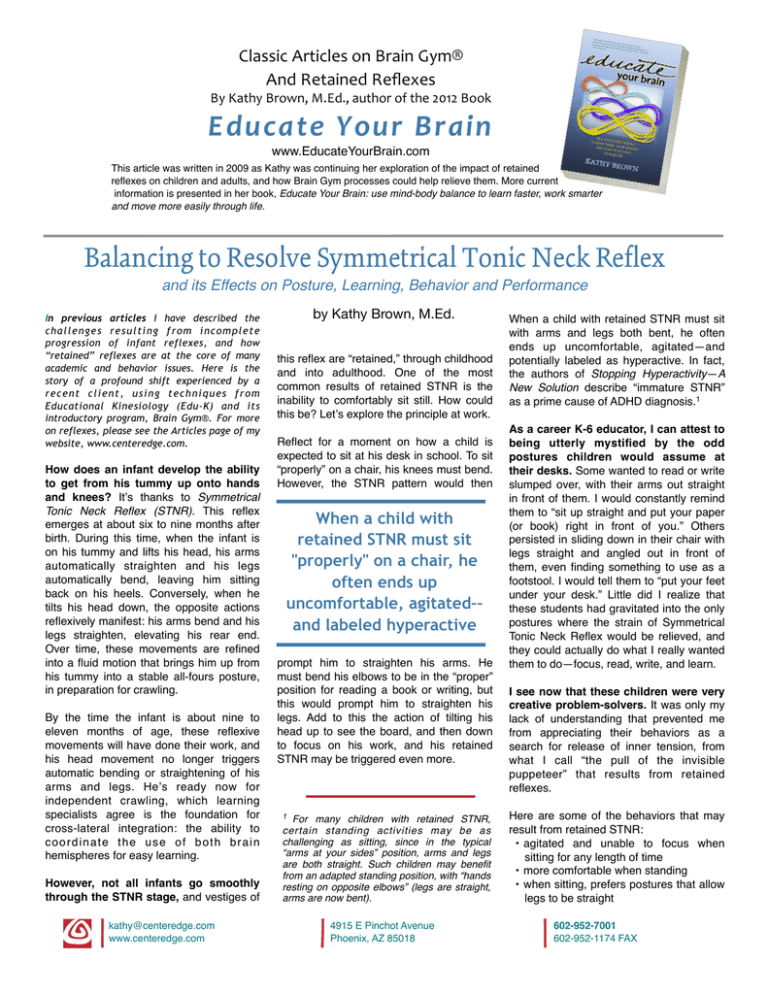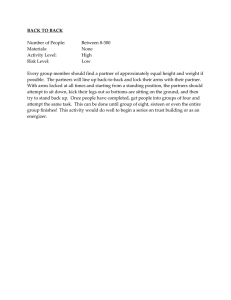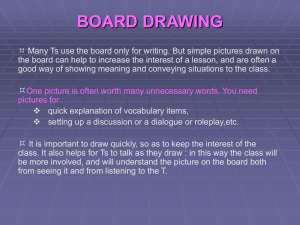
Classic Articles on Brain Gym®
And Retained Reflexes By Kathy Brown, M.Ed., author of the 2012 Book E ducate Your B rain
www.EducateYourBrain.com
This article was written in 2009 as Kathy was continuing her exploration of the impact of retained
reflexes on children and adults, and how Brain Gym processes could help relieve them. More current
information is presented in her book, Educate Your Brain: use mind-body balance to learn faster, work smarter
and move more easily through life.
Balancing to Resolve Symmetrical Tonic Neck Reflex
and its Effects on Posture, Learning, Behavior and Performance
In previous articles I have described the
challenges resulting from incomplete
progression of infant reflexes, and how
“retained” reflexes are at the core of many
academic and behavior issues. Here is the
story of a profound shift experienced by a
re c e n t c l i e n t , u s i n g t e c h n i q u e s f ro m
Educational Kinesiology (Edu-K) and its
introductory program, Brain Gym®. For more
on reflexes, please see the Articles page of my
website, www.centeredge.com.
How does an infant develop the ability
to get from his tummy up onto hands
and knees? Itʼs thanks to Symmetrical
Tonic Neck Reflex (STNR). This reflex
emerges at about six to nine months after
birth. During this time, when the infant is
on his tummy and lifts his head, his arms
automatically straighten and his legs
automatically bend, leaving him sitting
back on his heels. Conversely, when he
tilts his head down, the opposite actions
reflexively manifest: his arms bend and his
legs straighten, elevating his rear end.
Over time, these movements are refined
into a fluid motion that brings him up from
his tummy into a stable all-fours posture,
in preparation for crawling.
By the time the infant is about nine to
eleven months of age, these reflexive
movements will have done their work, and
his head movement no longer triggers
automatic bending or straightening of his
arms and legs. Heʼs ready now for
independent crawling, which learning
specialists agree is the foundation for
cross-lateral integration: the ability to
coordinate the use of both brain
hemispheres for easy learning.
However, not all infants go smoothly
through the STNR stage, and vestiges of
kathy@centeredge.com
www.centeredge.com
by Kathy Brown, M.Ed.
this reflex are “retained,” through childhood
and into adulthood. One of the most
common results of retained STNR is the
inability to comfortably sit still. How could
this be? Letʼs explore the principle at work.
Reflect for a moment on how a child is
expected to sit at his desk in school. To sit
“properly” on a chair, his knees must bend.
However, the STNR pattern would then
When a child with
retained STNR must sit
"properly" on a chair, he
often ends up
uncomfortable, agitated––
and labeled hyperactive
prompt him to straighten his arms. He
must bend his elbows to be in the “proper”
position for reading a book or writing, but
this would prompt him to straighten his
legs. Add to this the action of tilting his
head up to see the board, and then down
to focus on his work, and his retained
STNR may be triggered even more.
1
For many children with retained STNR,
certain standing activities may be as
challenging as sitting, since in the typical
“arms at your sides” position, arms and legs
are both straight. Such children may benefit
from an adapted standing position, with “hands
resting on opposite elbows” (legs are straight,
arms are now bent).
4915 E Pinchot Avenue
Phoenix, AZ 85018
When a child with retained STNR must sit
with arms and legs both bent, he often
ends up uncomfortable, agitated—and
potentially labeled as hyperactive. In fact,
the authors of Stopping Hyperactivity—A
New Solution describe “immature STNR”
as a prime cause of ADHD diagnosis.1
As a career K-6 educator, I can attest to
being utterly mystified by the odd
postures children would assume at
their desks. Some wanted to read or write
slumped over, with their arms out straight
in front of them. I would constantly remind
them to “sit up straight and put your paper
(or book) right in front of you.” Others
persisted in sliding down in their chair with
legs straight and angled out in front of
them, even finding something to use as a
footstool. I would tell them to “put your feet
under your desk.” Little did I realize that
these students had gravitated into the only
postures where the strain of Symmetrical
Tonic Neck Reflex would be relieved, and
they could actually do what I really wanted
them to do—focus, read, write, and learn.
I see now that these children were very
creative problem-solvers. It was only my
lack of understanding that prevented me
from appreciating their behaviors as a
search for release of inner tension, from
what I call “the pull of the invisible
puppeteer” that results from retained
reflexes.
Here are some of the behaviors that may
result from retained STNR:
• agitated and unable to focus when
sitting for any length of time
• more comfortable when standing
• when sitting, prefers postures that allow
legs to be straight
602-952-7001
602-952-1174 FAX
• on the floor, prefers “W” sitting, with feet
tucked back on either side
• poor eye-hand coordination
• poor at sports, especially swimming
(raising head to breathe causes arms
to automatically stiffen)
• difficulty copying from the board (rapid
adjustment of near to far focus)
• muscle tension in neck and shoulders
• legs on the move, or twisted around
chair legs
• skipping the infant crawling stage2.
Numerous educators I've talked with
describe what they see as a “growing
epidemic of hyperactivity” in children.
Could it be that many more children than
ever before have retained STNR? And if
so, where could this be coming from? I
have a theory: some infant-care practices
adopted in recent decades prevent
children from being on their tummy as
much as was historically the case.
A generation ago infants spent huge
amounts of time on their tummy—both
sleeping and playing. With the “back to
sleep” movement (recommended by
doctors to reduce the chance of SIDS,
Sudden Infant Death Syndrome), parents
now consistently position infants on their
back for sleeping; over-cautions parents
may translate this into a practice of never
putting infants on their tummy. In some
cases, infants even end up with “positional
plagiocephaly”—they are positioned on
their back so much, the back of their head
actually becomes flat from constant
contact with the surface beneath it.
Then thereʼs the prevalence of baby
carriers. The development of infant car
seats is an incredible boon for infant
safety. However, because car seats now
come with handles, parents have begun
carting their infants everywhere in them.
One mother I talked to realized that her
son had been in his baby carrier for more
than eight hours that day, what with her
commute, many errands, lunching with a
friend—and simply setting the baby in his
car seat next to her desk while she
worked. These carriers have become a
convenient means of managing infants. Is
their over-use preventing infants from
2
For infants with retained STNR, attempts at
crawling can be frustrating. When they look up,
arms stiffen, legs bend, and they must sit back;
when they look down, arms bend and they do a
nose-dive. In either case, they get nowhere.
Such children may give up attempts at crawling
altogether, or develop “different” means of allfours movement, such as backwards or
sideways.
getting the tummy-time (not to mention
vital human touch and variety of physical
movement) they need?
If an infant is seldom on her tummy, she
may not have the time (notice I say “time,”
as opposed to “occasional opportunity”)
required to explore her world from a
tummy-down position:
• What does it feel like to orient myself
this way?
• How is my view of the world different
from this position?
• How is the pull of gravity different, and
what does it take to raise my head?
• How different is it to feel the solid earth
under my tummy?
• How can my body move when Iʼm on
my tummy? (lifting arms and legs to
“fly,” and more)
All of these experiences build vital aspects
of her relationship to the world around her,
creating an integrated developmental
foundation for new movement patterns.
Then, six to nine months after birth, the
Symmetrical Tonic Neck Reflex emerges,
and when the infant raises her head she
One day he commented,
“You know, I think I’m
smarter standing up.
When I sit down I can’t
focus at all.”
automatically pushes up with her arms;
eventually her legs bend as well, and
sheʼs soon up on all-fours, as described in
the beginning of this article.
I wonder: If a child never has sufficient
tummy-time, is it even possible for her to
appropriately engage the STNR, rise onto
all-fours, learn all the vital brain-wiring
lessons from months of cross-lateral
crawling—and, then, appropriately
graduate to walking? Will her mind-body
system be waiting a lifetime to fully “use”
the STNR, so this reflex pattern can be
incorporated into more mature, intentional
movement, as the “trigger” for this reflex
simply fades away?
Time, and research, may tell. In the meantime, however, our world is full of children
(and adults) who daily expe-rience the
stress of retained STNR. How much better
it would be if intervention was never
needed in the first place. But Iʼm grateful
that STNR often responds quickly to
specialized Brain Gym/Edu-K processes.
I recently worked with “Ronny,” a very
bright, likable boy, whose teacher was
amazed (and frustrated) by how agitated
he was when sitting, and how poor his
focus was. Now in eighth grade, Ronny
was still struggling to achieve academically. I had worked with him several times
over the last few months, addressing
different aspects of reading and focus, and
after each session he showed progress.
However, he still lacked the ability to sit
quietly and work as well as was necessary
to succeed at that grade level.
As our sessions progressed over the
weeks and months, perhaps as a direct
result of the way Brain Gym processes
foster inner noticing, Ronny became a
very good observer of his own state. One
day he commented, “You know, I think Iʼm
smarter standing up.” What a revelation! I
asked for more details, and he continued:
“When I sit down, I canʼt focus at all.
Iʼm much happier standing. At home,
Iʼve found the best place for me to do my
homework is standing and using the
ironing board as a desk.” We created a
goal for his balance, which was to “sit
comfortably while I focus and learn.” Not
surprisingly, of all the processes available
on my Brain Gym/ Edu-K learning menu,3
Ronny was drawn to one that addresses
Symmetrical Tonic Neck Reflex.
This made so much sense! If Ronny had a
retained STNR, he would feel agitated
when sitting with both his arms and legs
bent. Standing at the ironing board, his
legs would be straight, but his arms would
be bent so he could hold a book or write.
He had found the perfect physical posture
to relieve himself of the pull of the invisible
puppeteer.
I led Ronny through some pre-checks to
determine if STNR was present. One
involved seeing if he experienced stress
while sitting or standing. (This was
determined through the Applied Kinesi-
3
Since Brain Gym and Edu-K are built on the
“drawing-out” model, the facilitator does not
“diagnose and fix,” by observing behaviors and
then selecting a certain technique for the
learner. Through various means of noticing and
choosing, the learner will find himself drawn to
a specific balance process from a “menu” of
available processes. It never fails: the learner is
always drawn to the “perfect” process to resolve
his or her own challenge, in essence selecting
his own path to wholeness.
ology process of “muscle-checking,” which
challenges the ability of a muscle to “hold”
in certain positions, revealing aspects of
systemic stress.) When seated (legs bent)
he was stress-free only with his arms
straight; when standing (legs straight), he
was stress-free only with his arms bent.
No wonder he felt so agitated when he
had to assume a typical seated posture!
The process Ronny had chosen from
the learning menu was Total Core
Repatterning, a technique developed by
Dr. Paul Dennison (which he teaches in a
course by the same name). Following this
process, we rechecked Ronnyʼs postural
stresses. While these checks did not
indicate that the reflex was completely
resolved, they showed there was great
improvement.
Following this session I had a discussion
with Ronnyʼs teacher. I explained to him
how a retained STNR results in the
inability to sit still and focus, and how he
could help Ronny learn more easily by
creating a space where he could do his
work standing up, perhaps in the back of
the room. Ronnyʼs teacher immediately
grasped the concept and created a
“standing work space” by placing a box on
top of a table, to position Ronnyʼs work at
just the right level for him. He also gave
Ronny permission to move from his desk
to that standing work space as needed.
When I worked with Ronny again two
weeks later, he was excited to report all
the positive changes he'd experienced
since our last session. He was very
pleased that his teacher was allowing him
to stand at the back of the room to do his
work, but said that he didn't always need
to, and that sitting was much more
comfortable than ever before. He also said
that he has much better compre-hension
when he reads, and is even passing more
tests. He had just received a social studies
test from his teacher, and had earned
Interesting side note — Since writing this
article I have come across coverage both on
ABC News and in The New York Times of
schools in 18 states introducing “adjustable
height standing desks” into the classroom. The
primary goal of the teacher who began this
trend was to address childhood obesity by
allowing students to be more active. Teachers
are already noticing improvements in behavior,
focus, and the ability to perform academically. I
wonder how much of this change comes from
the fact that children's STNR is not at issue
when they're standing to do their work? See
"Students Stand When Called Upon, and When
Not," at www.nytimes.com, and "Facelift for
America's Classrooms" at www.abcnews.com.
100% on it. We definitely celebrated all
these changes!
reading and writing, because the former
agitation from sitting is simply gone.
In this session, Ronny wanted to continue
his focus on sitting comfortably. The
postural prechecks from our last session
still showed a stress response, and Ronny
again chose Total Core Repatterning from
the learning menu.
Ronny will still benefit from additional
sessions to address other areas of
learning challenge, but this STNR shift will
certainly go a long way toward providing a
new, more integrated foundation for all his
future changes.
This time when we were finished, his
post-checks were solid: sitting or
standing, he showed no stress at all,
whether his arms were straight or bent.
He was delighted!
Three weeks later, both Ronny and his
teacher reported that he is much more
able to sit still in the classroom, and his
focus has improved as well. Ronny told
me that he no longer feels the need to
stand or move around in order to
concentrate; he is perfectly comfortable
and focused doing his homework sitting at
a table. He no longer has to stand while
Recommended Resources:
• Learning, Reflexes and Behavior: A Window
Into the Childʼs Mind by Sally Goddard
• Stopping Hyperactivity: A New Solution - A
Unique & Proven Program of Crawling Exercises
for Overcoming Hyperactivity by Nancy E.
O'Dell, Ph.D. and Patricia A. Cook, Ph.D.
• Several courses in the Edu-K curriculum
address STNR and other reflexes. The specific
course mentioned here, Total Core Repatterning,
is open to graduates of Brain Gym® 101 and
Edu-K In-Depth. See www.braingym.org
©2009-2012 Kathy Brown, www.centeredge.com. All
rights reserved. Brain Gym® is a registered trademark
of Brain Gym® International.
Sample page from Educate Your Brain
This page from the section discussing Infant Reflexes in Educate Your Brain,
shows seated postures that reflects STNR. From the new book by Kathy Brown.
For more information and to order your copy, go to
www.EducateYourBrain.com



